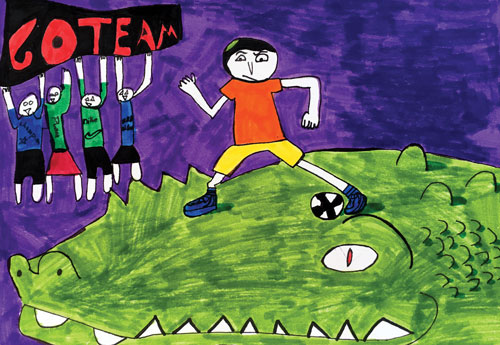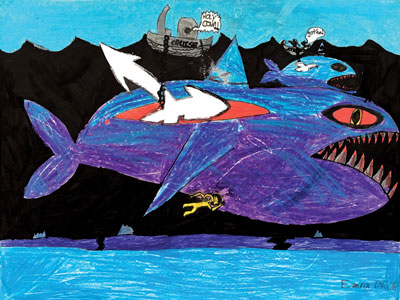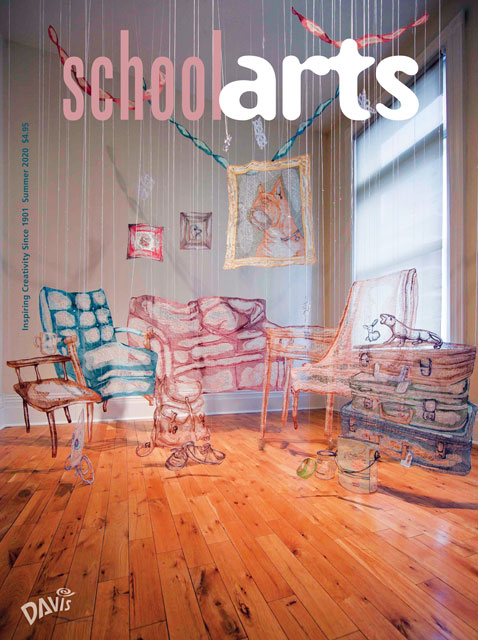 |
 |
| Top: Eitan H. Bottom: Charna B. |
My students had encountered their critics before; they were excited to put a name to the experience. “You may notice your inner critics getting louder and meaner as you get older. When you were in kindergarten, every one of you was proud to call yourself an artist. How many of you would call yourself an artist now?”
One of my goals as an art teacher is to make sure all of my students create art that is personal and unique to them. I attend NAEA conventions with that goal in mind. In 2019, Laura Lee Gulledge offered a session called 10 Practices for Cultivating Daring, Healthy, and Empowered Visual Storytellers. She tossed good ideas around like confetti. “Draw a portrait of your inner critic” is the one that struck me. I knew it would provide fertile soil for my students’ creativity.
 |
 |
 |
Top: Adina A. Middle: Ezra D. Bottom:
Alexandra P. |
The Art Challenge
I had to structure the project around our state objectives, and fourth- and fifth-grade classrooms seemed like the ideal place to introduce it. I asked students to each create a piece to represent their inner critic and how they relate to each other. They used composition to demonstrate those relationships, proportion to show the volume of their critics’ voices, and color to create mood and/or emphasis in their art. The project required students to create meaningful symbols and metaphors.
I showed students examples of expressive, symbolic, and surrealist art such as Yuko Shimizu’s Battle Hymn of the Tiger Mom and Jeremyville’s Forgive Yourself. The presentation was compelling enough that everyone recognized the problem. A few students were able to visualize their inner critics easily. They were excited to commit their emotions to paper. Most of my students, though, required coaching. It’s one thing to recognize your inner critic—drawing it is another matter.
Helpful Questions
After a couple of conversations, I determined the basic questions that would help students approach the challenge: What activities or situations frustrate you? What do you say to yourself when you feel frustrated? How do those ideas make you feel? Once I had the answers to those questions, I could reflect them back at students to help them come up with their own original concepts. One student drew a monkey distracting her from her homework.
A snake waited to strike if a piano player made a mistake. An unseen crocodile hid below the feet of a successful soccer player. One student drew me as her inner critic. “Rude!” Her classmates protected me. “No, no,” I disagreed, “Most of my old art teachers are still up here in my head somewhere.” Her drawing gave us all a chance to discuss the difference between real criticism and the criticism that we imagine.
Positive Criticism
I was delighted to discover that many of my students were supported by their inner critics. “When I feel discouraged, I just think ‘You got this! You can do this!’” Little sisters imagined their big sisters coaching them. A happy flower encouraged a frustrated artist to “Just keep going! Don’t give up.” Discussing their work revealed different ways that we can relate to our inner critics.
These positive examples inspired an important discovery: As long as we never give up, criticism helps us to grow. If we refuse to be discouraged, criticism helps us to identify problems and maybe even solve them. One of my own favorite teachers described the experience as having two brains: a critical brain and a creative brain. An artist needs both, but the two brains cannot operate at the same time. With that in mind, I encouraged students to “Let your two brains take turns. Create without judgment. When the time comes, be critical, then create again.”
Reflections
This project allowed students to illustrate their own psychologies. The artwork was so personal that everyone was curious to study, share, and listen to each other’s explanations.
The idea of inner criticism was illuminated. “I didn’t realize that I could talk back,” one boy said after studying a classmate’s drawing. “I don’t have to listen to my inner critic!” No, you don’t! Only one student balked at the assignment. “I can’t do this,” he protested. “I don’t even know what to draw.” His classmates called him out instantly, “That’s your inner critic!” They laughed. He chuckled, busted. He drew a picture of himself talking with his drawing. “We could do this project every year,” one of his classmates added, “because my inner critic is already changing. If I drew it again, it would be completely different.”
Rama Hughes is an art teacher at Yavneh Hebrew Academy in Los Angeles, California, and a contributing editor for SchoolArts. rama@ramahughes.com
NATIONAL STANDARD
Connecting: Relating artistic ideas and work with personal meaning and external context.
WEB LINK
Rama Hughes: ramahughes.com
View this article in the digital edition.







